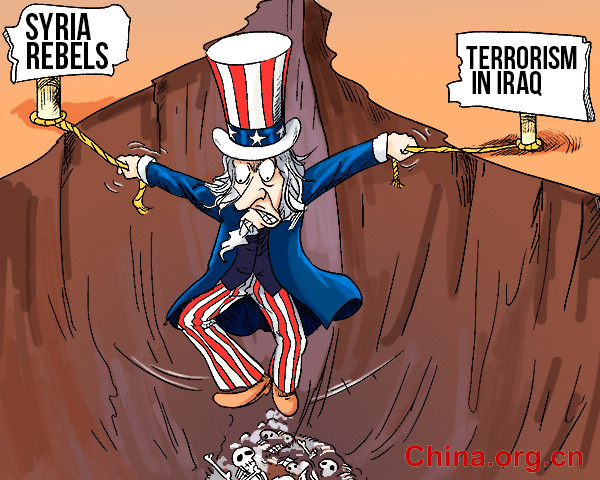The new geopolitics of West Asia: strategic ambiguity and surprise
- By Mohsen Shariatinia and Ehsan Razani
 0 Comment(s)
0 Comment(s) Print
Print E-mail China.org.cn, May 21, 2015
E-mail China.org.cn, May 21, 2015
|
[By Yang Yongliang/China.org.cn] |
The changing geography of terrorist aims
While the main focus of terrorist groups for destruction was the interests of the Western world in the past, today the geography of terrorist aims are largely focused on the countries of West Asia. Terrorists have increasingly defined the people of these countries as the main targets for their brutal operations, making Iraq, Syria, and Libya as the "Sick Men" of the Middle East. Probably in the mid to long term, the strategic energy of the countries in the West Asian region will be devoted to confronting terrorist currents, most importantly ISIS.
Furthermore, the changing geography of terrorist destructions will lead to the increasing spread of ungoverned territories facing countries with mafia gangs, criminal groups, and terrorism alongside their borders.
The "Africanization" of the security environment in the West Asia is another result of the changing geography of terrorist activities in this region. In fact, the patterns of conflict, poverty, homelessness, epidemics, vast degradations of the environment and desperate people, which have constantly been considered as the major defining features of Africa are gradually becoming the distinguishing characteristics of important parts of Western Asian countries.
Changing U.S. strategic behavior
All through the years after 9/11, the United States became deeply engaged in the West Asian region. But after Obama came to power, the United States' willingness to militarily interfere in the Middle East sharply reduced. Notwithstanding the reasons for the U.S disengagement, this policy has had considerable impact on the strategic environment of West Asia.
One of the most likely consequences of this policy change would be the change that the key U.S allies, i.e. Israel and Saudi Arabia, could see in their regional roles. Today, there are serious discussions in academic and policy circles working on international politics regarding the Israeli and Saudi Arabian efforts to reduce their reliance on the United States and to diversify their network of strategic friends. Such efforts may lead these actors to a new kind of strategic behavior, such as that can be seen today in Yemen.
Conclusion
This is the era of power transitions in West Asia, making the geopolitics of this region much more complicated than the past. Indeed, the power transitions are going to be very transparent at the national, regional, and international levels. At the national level, a power struggle is taking place between West Asian governments and the societies as well as some social groups, including extremist ones.
Regionally, the strategic rivalry has intensified between regional powers in West Asia. And at the global level, the U.S. disengagement policy in West Asia coincided with the increasing role of China and Russia. As a result of the dynamics of power transitions in the West Asia, the geopolitics of the region has taken on new features; the most important of them is perhaps unpredictability.
Mohsen Shariatinia is a research fellow of the Center for Strategic Research in Tehran, Iran.
Ehsan Razani is member of the School of Law and Politics, Islamic Azad University, Shahrood, Iran.
Opinion articles reflect the views of their authors, not necessarily those of China.org.cn.







Go to Forum >>0 Comment(s)